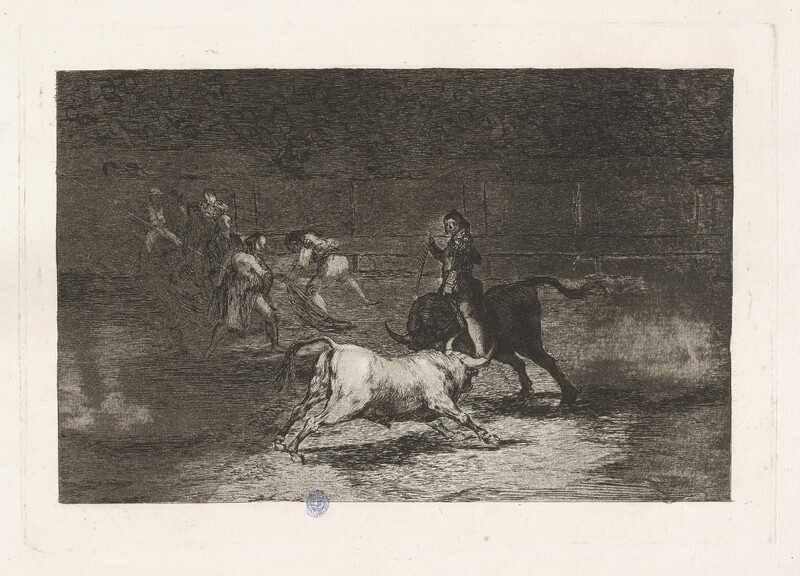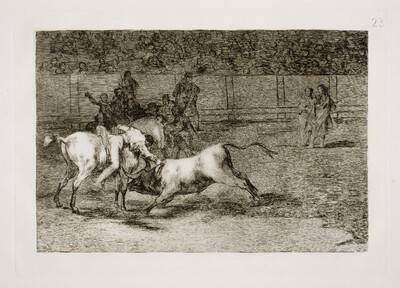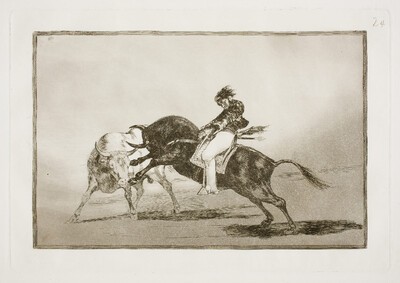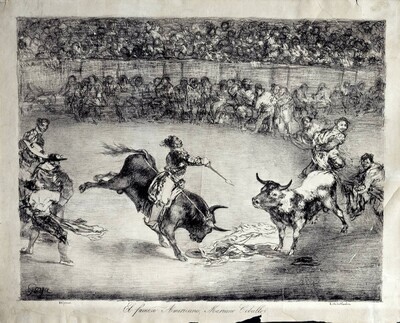- Cronología
- 1814 - 1816
- Dimensiones
- 245 x 350 mm
- Técnica y soporte
- Reconocimiento de la autoría de Goya
- Documented work
- Ficha: realización/revisión
- 02 Oct 2021 / 22 Jun 2023
- Inventario
- 225
Dutuit Collection identification stamp (stamped in blue ink, lower centre-left)
See How the ancient Spaniards hunted bulls on horseback in the countryside
This work is one of a group of five prints discarded by Goya and not included in the first edition of the Bullfighting, of which the copper plates have not survived, so they could not have been included in later editions of the series, as was the case with the seven that Loizelet added in 1876 in the third edition. Of the five prints mentioned above, identified by Gassier with the letters H-L, only a few state proofs and their preparatory drawings have survived. Of a sixth print, of which the copper was never opened, only the preparatory drawing is extant.
Only two state proofs have survived of the present print, both with the etching, aquatint and drypoint, one in the National Library of Spain (Inv. 45681) and the other in the Dutuit Collection of the Musée du Petit Palais in Paris (GDUT 5431). Both proofs are from the same and only known state. The one in the Dutuit Collection entered the Musée du Petit Palais in 1902 as part of the bequest of the brothers Auguste and Eugène Dutuit, although it had previously belonged to the Madrid collection of Valentín Carderera and then to the Galichon collection in Paris, where it was already in 1887. The state proof in the National Library also belonged to the collection of Valentín Carderera, who bought it from Mariano Goya y Goicoechea, the painter's grandson.
The catalogue data shown and the image reproduced correspond to the state proof of the Dutuit Collection in the Musée du Petit Palais, Paris.
See How the ancient Spaniards hunted bulls on horseback in the countryside
Several authors agree that this print is an early version of the one that Goya included in the official bullfighting series under the title Ceballos himself mounted on another bull that broke the bullfights in the bullring in Madrid. The subject depicted is the same: the famous bullfighter Mariano Ceballos, alias " The Indian ", on top of a bull, trying to thrust a rejón at another bull coming towards him. There are a number of secondary figures in the bullring, no doubt members of Ceballos's cuadrilla, although in much smaller numbers than in the preparatory drawing, which is also entitled Mariano Ceballos riding a bull with a "rejón" ( Bullfighting J). They are with their capes, ready to go into action if necessary. In the background we can also make out a picador on his mount, as in those days they never left the bullring in case they were needed.
The scene is very dark, there is a large stain on the right and the grain of the aquatint is clearly visible, which some authors consider sufficient reasons to explain why Goya discarded this print.
Due to its subject matter, the engraving is related to two other prints by Goya featuring Mariano Ceballos, apart from the one mentioned above: Mariano Ceballos, aka "the Indian", kills the bull from his horse and The famous American, Mariano Ceballos.
-
París1966cat. 64
-
París1986
-
Ydioma universal: Goya en la Biblioteca NacionalBiblioteca NacionalMadrid1996from September 19th to December 15th 1996cat. 277
-
París2008
-
1868p. 175
-
MadridBlass S.A.1918pp. 134-135 y 140
-
1941pp. 186 y 192
-
1946pp. 177-216, espec. p. 215
-
BarcelonaTartessos-F. Oliver Branchfelt1946 (reed. 1951)
-
OxfordBruno Cassirer1964vol. II, 1964, p. 360, cat. 246
-
Vie et ouvre de Francisco de GoyaParísOffice du livre1970p. 281, cat. 1237
-
MilwakeeMilwaukee Art Museum1986p. 19
-
Catálogo de las estampas de Goya en la Biblioteca NacionalMadridMinisterio de Educación y Cultura, Biblioteca Nacional1996cat. 370
-
Ydioma universal: Goya en la Biblioteca NacionalMadridBiblioteca Nacional, Sociedad Estatal Goya 96 y Lunwerg1996p. 249
-
MadridMuseo Nacional del Prado2001p. 109
-
Goya. In the Norton Simon MuseumPasadenaNorton Simon Museum2016pp. 186-201




